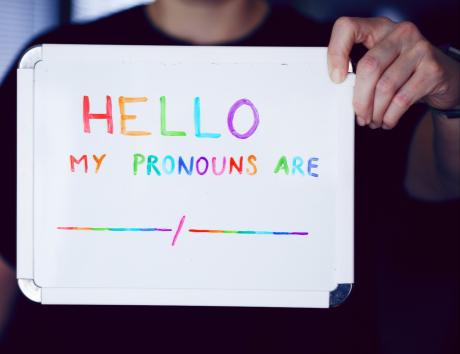How To Include Preferred Name and Pronouns on Resumes
Including your pronouns on resumes is becoming increasingly common. This practice helps transgender individuals and anyone with non-traditional pronouns feel confident in their job search and allows cisgender people to show their support. This guide details how to include your pronouns and preferred name on resumes the right way.

How to include pronouns on a resume
This practice is increasingly popular and shows your commitment to inclusivity, as well as your confidence in yourself. So where to put pronouns on resumes?
The most common way is to put your pronouns in parenthesis or brackets right after your name in your contact details. Here’s an example resume header:
Jordan Maxwell (they/them)
Customer service representative
555-9774
jordanmax@example.com
Seattle, WA
You can also include your pronouns in a separate line below your name, right before your job title.
Some professionals include their pronouns in the resume summary or objective section right after their job title. Here’s a sample:
“Dedicated marketing manager (he/him) seeking new challenges and opportunities.”
If you decide to use this method, be sure to have a friend proofread it, as it can sound a bit confusing or cluttered if you aren’t careful.
We also recommend placing your pronouns in a few other professional places to reinforce your preferences and clarify confusion:
- Your LinkedIn profile
- Your email signature
- Your cover letter
- Your Slack profile
And you won’t be alone. Thousands of professionals include pronouns on their LinkedIn profiles, email signatures, and Slack profiles. Even if you aren’t in the LGBTQ+ community, this practice is a great way to normalize the practice and show your commitment to inclusivity. This means that this act makes you stand out to inclusive, diverse organizations.
How to put your preferred name on resumes
Yes, you can put your preferred name as your full name on your resume. Place it in your header alongside your job title and phone number, just as you would your legal name. This gives you a boost of confidence, helps connect you to your application, and ensures the hiring manager calls you by the right name. It also establishes your relationship on the right foot – you wouldn’t want your future manager to get used to calling you the wrong thing.
If you aren’t sure about your preferred name yet or are simply uncomfortable putting a name that isn’t legal, consider using an initial like J. Maxwell. You can also use a gender-neutral nickname for your legal name. If your legal name is Samantha Rogers, try using Sam Rogers. This is a common strategy used by all types of professionals, including people who believe their name is too unusual and want to sound more common.
Keep in mind that you must be prepared to provide your legal name on certain documents, including background checks and insurance forms. However, don’t be afraid to talk to HR about your legal name and ensure it’s only used in legal documents, never in conversation or work profiles.
Formatting and placement considerations
We recommend placing your pronouns right in your resume header, either right after your full name or in a bullet list alongside your job title and phone number. This ensures the recruiter sees them right away and doesn’t miss them – it also ensures that they won’t clutter up or distract the rest of your resume.
Use a standard, clear font to make your pronouns easy to read. Most pronouns use a forward slash to separate them, and a tight font could make it difficult to understand or simply uncomfortable on the eyes.
Make it clear if you use multiple sets of pronouns by including both sets. You can say this simply by separating one of each with a forward slash: Kelly Mayer (She/Them). However, it’s also acceptable to list both sets separately: Kelly Mayer (She/Her) (They/Them).
Don’t sweat the format; grab one of our professional resume templates. Using one of our beautiful resume layouts lets you concentrate on listing your pronouns and crafting the perfect resume, not white space and formatting.
Expert Tip:
Best practices for inclusive resume writing
Inclusive practices don’t just showcase your beliefs – they also support modern values and show respect for other people and diverse organizations. Check out our top tips for crafting inclusive job applications.
Use inclusive language throughout
Avoid exclusive terminology, including gender-coded words and he/she pronouns. Don’t make assumptions about the hiring manager and avoid he/she pronouns unless you specifically know they use them through their LinkedIn or other social media channels.
If you don’t know their name, greet them with “Dear Hiring Manager” instead of “Sir/Madam.” If you do know their name but not their pronouns, don’t guess them and stick to their full name. For example, instead of “Ms. Smith,” you can say “Kayla Smith.”
Weave your commitment to inclusion in your application
Incorporate your stance on diversity into your resume to showcase your values. This is particularly important for HR staff and managers, as potential employers will want to know that you can support and spread their values.
Consider including a statement about your commitment to inclusion in your resume summary. Here’s an example:
“Dedicated to creating a welcoming and inclusive work environment, ensuring each employee feels a sense of belonging.”
For more creative ideas on how to craft summaries and objectives, browse our resume examples.
Use your name and pronouns consistently
Scour your online profiles, social media channels, resumes, and cover letters and ensure they all use the same preferred name and pronouns. This enhances consistency and professionalism and ensures your employer won’t accidentally get it wrong. This practice also helps you establish your name and pronouns throughout your professional space.
If you have any colleagues who still know you by your previous name and pronouns, ensure you contact them and let them know about the change. You want to ensure your entire network refers to you using the same terms.
Addressing common concerns
The subject of pronouns can be delicate, and many professionals worry that they might be negatively received by potential employers.
Research the company before you apply and try to discover its stance on inclusivity, diversity, and LGBTQ+ people. Listing these values on company websites is increasingly common, so it’s often easy to find.
If you aren’t bothered by using your legal name occasionally, create a second resume template that you use with employers you aren’t sure of. You can then share your pronouns and preferred name with the hiring manager when you’re further into the process.
Unsure about the process? Consider speaking with a career counselor or trusted advisor if you aren’t sure how employers will take your identity. It’s not only important to be comfortable as you apply for jobs, but it’s also vital to stay out of dangerous situations. If you believe a company could be abusive or slandering towards LGBTQ+ individuals, avoid them and seek guidance.
We recommend searching your network and asking for referrals. Your colleagues and friends are great resources for finding positive, inclusive employers who are receptive to unique pronouns and identities.
“Inclusive practices don’t just showcase your beliefs – they also support modern values and show respect for other people and diverse organizations.
Represent your authentic self by putting your pronouns on resumes
Listing your pronouns and preferred name on resumes is an empowering act, and it helps you establish your professional identity before you even meet for a job interview. Here are our top takeaways:
- Provide your pronouns in your resume header, right after your full name or in the list underneath
- List your preferred name on resumes, cover letters, and online profiles
- Use your legal name when filling out legal documents, including insurance forms and background check forms
- Don’t assume the hiring manager’s pronouns or gender, and use gender-neutral language
Get started right away with CVwizard’s resume maker. Easily include your pronouns in your resume header and weave your commitment to inclusivity in your summary with just a few clicks.
Make an impression with your resume
Create and download a professional resume quickly and easily



